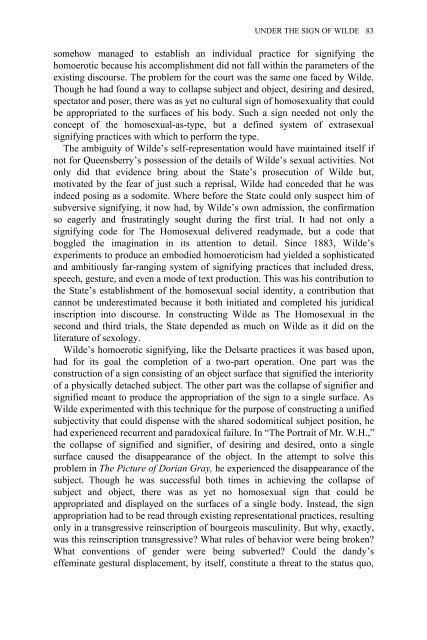Edited by Moe Meyer - Get a Free Blog
Edited by Moe Meyer - Get a Free Blog
Edited by Moe Meyer - Get a Free Blog
Create successful ePaper yourself
Turn your PDF publications into a flip-book with our unique Google optimized e-Paper software.
UNDER THE SIGN OF WILDE 83<br />
somehow managed to establish an individual practice for signifying the<br />
homoerotic because his accomplishment did not fall within the parameters of the<br />
existing discourse. The problem for the court was the same one faced <strong>by</strong> Wilde.<br />
Though he had found a way to collapse subject and object, desiring and desired,<br />
spectator and poser, there was as yet no cultural sign of homosexuality that could<br />
be appropriated to the surfaces of his body. Such a sign needed not only the<br />
concept of the homosexual-as-type, but a defined system of extrasexual<br />
signifying practices with which to perform the type.<br />
The ambiguity of Wilde’s self-representation would have maintained itself if<br />
not for Queensberry’s possession of the details of Wilde’s sexual activities. Not<br />
only did that evidence bring about the State’s prosecution of Wilde but,<br />
motivated <strong>by</strong> the fear of just such a reprisal, Wilde had conceded that he was<br />
indeed posing as a sodomite. Where before the State could only suspect him of<br />
subversive signifying, it now had, <strong>by</strong> Wilde’s own admission, the confirmation<br />
so eagerly and frustratingly sought during the first trial. It had not only a<br />
signifying code for The Homosexual delivered readymade, but a code that<br />
boggled the imagination in its attention to detail. Since 1883, Wilde’s<br />
experiments to produce an embodied homoeroticism had yielded a sophisticated<br />
and ambitiously far-ranging system of signifying practices that included dress,<br />
speech, gesture, and even a mode of text production. This was his contribution to<br />
the State’s establishment of the homosexual social identity, a contribution that<br />
cannot be underestimated because it both initiated and completed his juridical<br />
inscription into discourse. In constructing Wilde as The Homosexual in the<br />
second and third trials, the State depended as much on Wilde as it did on the<br />
literature of sexology.<br />
Wilde’s homoerotic signifying, like the Delsarte practices it was based upon,<br />
had for its goal the completion of a two-part operation. One part was the<br />
construction of a sign consisting of an object surface that signified the interiority<br />
of a physically detached subject. The other part was the collapse of signifier and<br />
signified meant to produce the appropriation of the sign to a single surface. As<br />
Wilde experimented with this technique for the purpose of constructing a unified<br />
subjectivity that could dispense with the shared sodomitical subject position, he<br />
had experienced recurrent and paradoxical failure. In “The Portrait of Mr. W.H.,”<br />
the collapse of signified and signifier, of desiring and desired, onto a single<br />
surface caused the disappearance of the object. In the attempt to solve this<br />
problem in The Picture of Dorian Gray, he experienced the disappearance of the<br />
subject. Though he was successful both times in achieving the collapse of<br />
subject and object, there was as yet no homosexual sign that could be<br />
appropriated and displayed on the surfaces of a single body. Instead, the sign<br />
appropriation had to be read through existing representational practices, resulting<br />
only in a transgressive reinscription of bourgeois masculinity. But why, exactly,<br />
was this reinscription transgressive? What rules of behavior were being broken?<br />
What conventions of gender were being subverted? Could the dandy’s<br />
effeminate gestural displacement, <strong>by</strong> itself, constitute a threat to the status quo,


